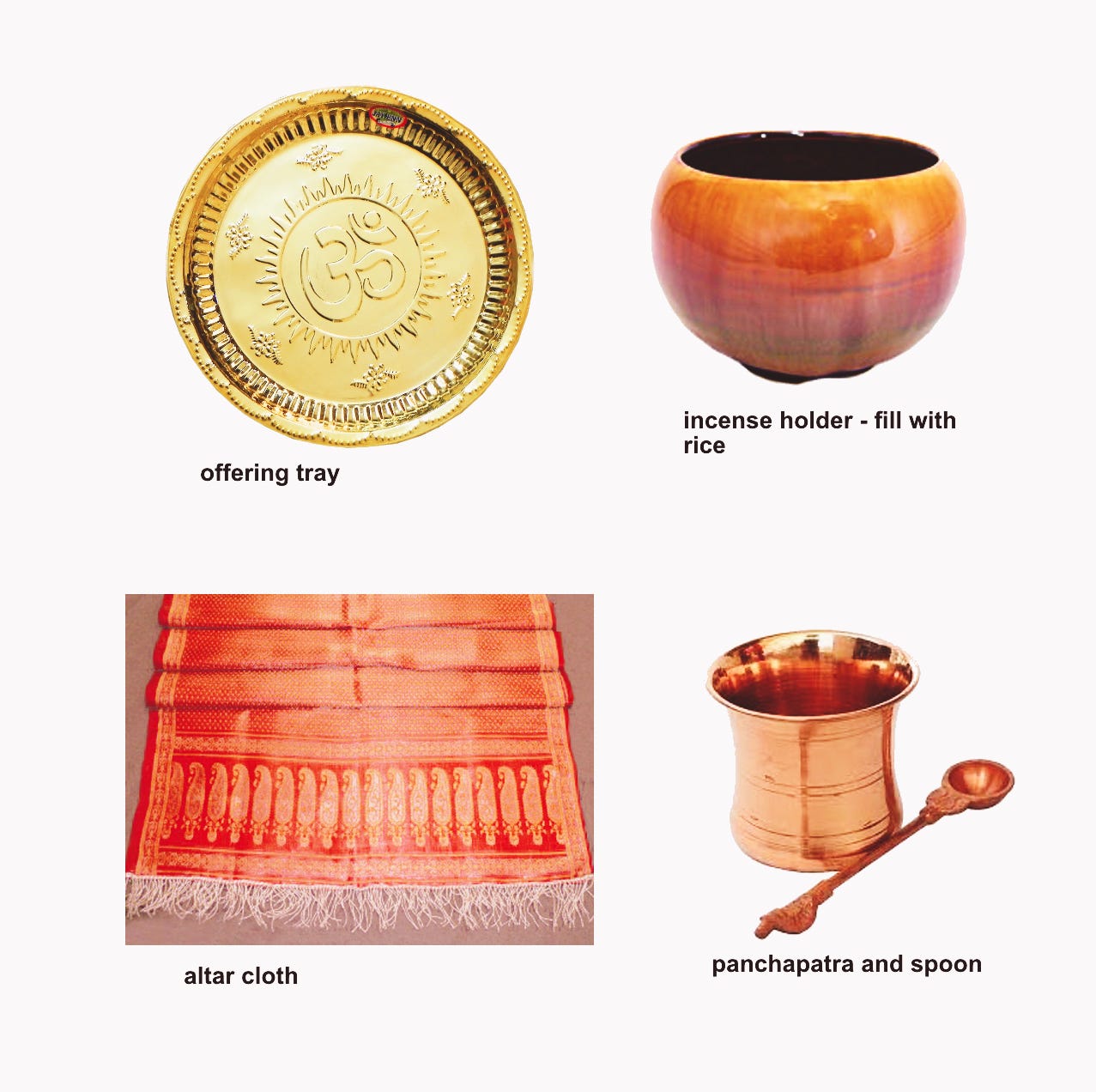Why altars?
The word “altar” comes from the Latin altārium, meaning “high,” or a place for sacrifice to what is great. It is also related to adolere, which means to worship and to burn up or sacrifice.
The Sanskrit word for “altar”, vedī (वेदी), has similar meanings. Vedī refers to a fire altar, a place of worship and ritual sacrifice.
In the Bhagavad Gita, Krishna tells the archer Arjuna that every action of a realized person is a ritual offering of self into the the Self, like pouring fire into fire or water into water. A realized person is both immersed in the Self and enacting the play of offering, the play of experiencing re-union.
When we sit down at our altars, we have the feeling that we are meeting the Self to offer our self into the Self.
Ritual space
From the moment we begin setting up our altars for the day and sitting down to practice, we are entering ritual space.
- Ritual space magnetizes us with beauty, allowing for relaxation and heart opening. In a sense, ritual space is our ideal world.
- The presence of the altar helps us to enter into bigger View. We begin to remember the real purpose of our lives.
- Ritual space exists outside of linear time. We may experience this only slightly, or we may notice a definite shift in our relationship to time when we are within ritual space.
- Day-by-day as we practice at our altars, the energy of our practice imbues itself in our implements, malas, offerings, our cushion, shawls, physical altar, and the space itself. Over time, it becomes even more of a support and a refuge.
Notice how your energy shifts as you handle the items on your altar, place the offerings, light the incense, and sit down.
Setting up your altar
- Set up your altar so that when you sit at it, you are facing East, Northeast, or North.
- Ideally, you altar should be in a private place in your home and not in a bedroom or office. Of course, many of us do not have this luxury. So if you need to put your altar in the bedroom, office, or a space that is public, I recommend putting a folding screen up around your practice area.
- Cover the base level of your altar with a clean silk cloth.
- An altar can have one or several levels.
- The base level is for your offerings, implements, and pictures and statues of deities.
- The second level is for pictures or representations of your teacher or Guru.
- If you have a third level, it would be used for symbols of the absolute such as a Shiva lingam.
- If you have only one level, make the picture of Guru or teacher larger, and place it in the center toward the back of the altar. Put symbols of the absolute on either side or directly in front of this. Put deities closer to you, toward the front of the altar and have them be somewhat smaller in stature than the image of Guru.
Altars and altar fixin’s
Altar tables
- Etsy is a great place to find a variety of handmade, beautiful altar tables.
- The Yankee Woodsmith creates multi-level altars in simple, elegant styles. They are on a break until April 1, 2024.
Bells
A clear, rich, resonant bell tone brings us immediately into a more nondual experience. You want your bell to be a good size, not too small. Smaller bells produce less effective sounds.
Two kinds of bells work best: Tibetan and Balinese. A good-quality Tibetan bell can be found in the U.S. at a Tibet shop for $40-75 USD. You can find many places to order Tibetan bells online.
Balinese bells are much more expensive and will set you back $200-300 USD. You can only find them online (unless you live in Bali!). They are sometimes referred to as “Balinese priest bells.” The sound is clearer with less grain than Tibetan bells. But I also love the sound of Tibetan bells.
It’s really difficult to buy a bell without trying it out first. But if you must buy online, then just find a reputable dealer.


All the trimmings


Most of these items can be found by searching for “puja supplies” online.
At a minimum, you need:
- One copper, silver, or brass plate for flower and food offerings.
- A small cup for offering water – this is traditionally called a panchapatra, but any new copper, brass, ceramic, or wood cup will do. Tibet shops have beautiful small copper bowls and cups that are used for offerings and ghee lamps. You can use them for water and even food offerings.
- An incense holder
- A silk altar cloth – If you happen to live somewhere with a commercial zone frequented by folks from India, you can find altar cloths at local fabric and clothing stores.
- A bell
- Incense – see below
- Representations of teacher, deity, and/or the absolute
Statues and pictures
There are lots of ways to get pictures of your teachers or teachers you love and your favorite deities. You can always download them, print them out, and frame them.
Statues are a little harder. Try to get ones that are solid brass, bronze, crystal, or sandalwood rather than painted composite. Lotus Sculpture is a good starting place. They have both Hindu and Buddhist options from the inexpensive to the wildly unaffordable.
Etsy and Ebay are good options for buying lingams and other symbolic forms made of various materials, both natural and carved. Many makers from India are selling on these platforms.
Incense
Japan Incense – Japanese incense really is the best, and once you try it, you won’t look back. This shop in San Francisco has friendly owners and a wide selection. At Jaya Kula, we like anything made by Minorien Fu-in.
Scented Mountain is a U.S.-based maker. They only sell agarwood incense, the most coveted scent in the world. They source their raw product sustainably from Vietnam. Their agarwood incense is unblended and so is a little more intense than the Japanese varieties. Agarwood is also known as aloeswood or oud.
Incense Traditions sells the finest temple incense from Tibet and Bhutan. Their selection is generally not expensive and, like most such incense, the blends contain herbs and minerals and sometimes substances produced during spiritual practice.
Grandawood is an Australian outfit that, like Scented Mountain, sources agarwood from Vietnam to make incense and oils. I haven’t tried Grandawood myself, but it comes highly recommended.
Make your altar a beautiful self-expression that calls you to practice and is a space you want to rest in even when you are feeling resistance to doing practice.
A simple way to begin your practice
Whether you are meditating, doing mantra japa, singing kirtan, or doing other practices, you can always start by making simple offerings at your altar.
- Clean your practice area. Put any offerings left over from the previous day outside for other beings to benefit from.
- Put fresh filtered or spring water in your offering cup and set it on your altar.
- Put a fresh flower or flowers on the offering tray. I sometimes float three flowers in the water. Just because I enjoy how it looks!
- Light a stick of incense.
- Gaze at your altar and the wisdom beings portrayed there. Ring your bell with your left hand while circling the incense three times clockwise with your right hand.
- Place the bell back on the altar and put the burning incense in its holder. Finish with a full-body prostration, a kneeling prostration, or a bow from the waist while holding anjali mudra (prayer mudra).
Enjoy your altar!
with infinite love,
Shambhavi
This post originally appeared on Shambhavi’s creative site: Kindred 108

